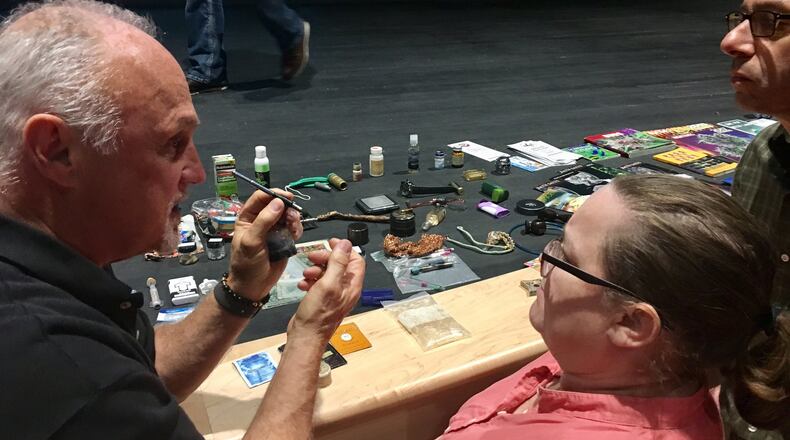“We’re in the midst of a heroin epidemic and opioid epidemic,” Neyer said, but added that youth do not typically start substance use with opioids.
Addiction, she said, is a progressive disease, and youth turn to substances that are increasingly destructive to their bodies.
MORE: 5 key events that spurred Ohio’s opioid epidemic
Each coalition uses the same core data and seeks to prevent or at least postpone use in youth “because it really does re-wire and hijack the brain,” she said.
“It really does re-wire and hijack the brain and encourage a lifetime of substance abuse if you use early, especially before the age of 15,” Neyer said. “You are drastically increasing your chances of living a lifetime of addiction if you use substances before that time.”
Founded in 2014, the Fairfield Prevention Coalition brings together leaders and experts in a variety of fields, including medicine, schools, youth, parents, police departments, juvenile justice and drug/alcohol treatment providers.
Coalitions aren’t on their own. They reach out to various entities to work with them on programming, including law enforcement, community task forces, mental health professionals, social worker, health care systems, non-profits, churches, fire departments and local governments.
MORE: 5 ways to to talk to your young child about the opioid epidemic
There’s been a local reduction in the amount of overdose deaths, which is “a huge testament to communities and different entities working together” and talking to come up with solutions.
“It’s amazing how many people are now communicating with one another … about the work that we do,” she said. “We’re getting out of the silos because people are dying, and hopefully as a result of that (working together), we’ll all have a better system of communication, not as much duplication of efforts and a very efficient use of funds.”
Those funds recently saw a boost. Twenty-five Ohio organizations will receive $125,000 grants for drug prevention programs, including Coalition for a Healthy Middletown, Fairfield Prevention Coalition, the Butler County Coalition and the Montgomery County Prevention Coalition, U.S. Sen. Rob Portman and Sherrod Brown announced last week.
The grants were announced through the Drug-Free Communities Act, which provides matching federal grants for programs aimed at drug prevention. Portman authored the bill in 1997, when he was a member of the U.S. House of Representatives.
MORE: County sues drug companies for $5 million
Neyer said prevention coalitions also utilize social media, including videos, to raise awareness of the opiate epidemic. They also work with police departments and quick response teams, who are working together with social workers and EMTs to “connect the dots” between those people who have overdosed and treatment facilities and other options.
Kristy Duritsch, executive director, of the Safety Council of Southwestern Ohio, which includes substance abuse prevention group Coalition for a Healthy Middletown, said drug free coalitions look at the big picture, but focus on prevention.
“With a focus on youth, we look at who is using, when, where, what they are using, why they are using and what puts them more at risk or what helps to prevent them from choosing to ever use, Duritsch said.
That said, there is “no cookie-cutter fix” to the problem of addiction, she said.
Instead, prevention coalitions are working to use data to create change: change in perceptions of harm, barriers to access, incentives for positive behavior and policies and procedures that make it easier for youth to make healthier choices.
MORE: Family drug court resurrected
Coalitions, she said, bring all the sectors of the community together to impact the entire area served. They also know a few things about opioid and other drug abuse. For starters, the leading reason youth in grades 7 to 12 choose not to use tobacco, alcohol and other substances is parental disapproval, she said.
“So we provide information and promote websites like www.starttalking.ohio.gov and www.preventionactionalliance.org to help give them the skills to have those conversations early and often,” Duritsch said. “We encourage parents to set clear rules and to enforce them.”
Prevention coalition officials also know that when the perception of harm goes up, use rates go down, Duritsch said.
“Unfortunately, with all the mixed messages about marijuana, perception of harm has gone down,” she said. “It’s perceived to be the least harmful substance … including tobacco. So we know we need to educate youth and adults about its harmful effects, especially with chronic use.”
In addition, prevention coalition leaders know that participation in after-school and community activities and faith organizations reduces the risk of using youth using, so Butler County coalitions and others in the community are working to increase these opportunities and getting the faith community engaged, Duritsch said.
MORE: What is fentanyl? 10 things to know about the potentially deadly drug
Like all of you, we care deeply about our community, and want it to be the best it can be. There is much to celebrate in Butler County, but we also face serious challenges. If we don’t find solutions to them, our community will never be its best.
This month, we begin a project examining the current state of the opioid epidemic, and will explore throughout September how Butler County has responded, and what a recovered community would look like.
About the Author

